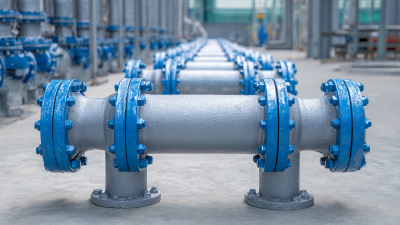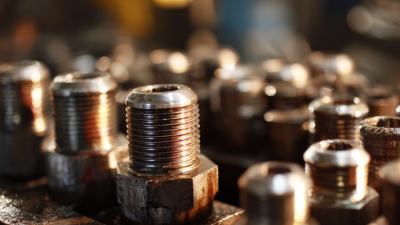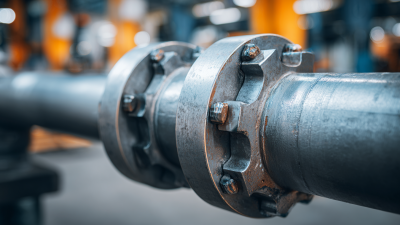The global market for pipe valves and fittings is witnessing significant growth, driven by rising demand across various industries, including oil and gas, water treatment, and construction. According to a recent report by ResearchAndMarkets, the pipe valves and fittings market is projected to reach USD 130 billion by 2026, reflecting a compound annual growth rate (CAGR) of 5.2% from 2021 to 2026. This growth is largely fueled by the increasing focus on infrastructure development, particularly in emerging economies where urbanization and industrialization are accelerating.
As industries evolve, so too do the technologies and materials used in pipe valves and fittings. For instance, advancements in smart valve technology are enhancing operational efficiency and safety in fluid management systems. The shift towards sustainable and resilient infrastructure also emphasizes the importance of using high-quality, durable materials for fittings and valves, ensuring longevity and efficiency. In this context, understanding current trends and future projections is essential for stakeholders to navigate the complexities of this dynamic market effectively. This exploration will delve into the essential role of pipe valves and fittings, examining the top five trends that are shaping the industry's future landscape.

Pipe valves play a crucial role in fluid control systems, ensuring efficient operation across various industries, including oil and gas, water treatment, and chemical processing. According to the latest report by MarketsandMarkets, the global market for valve systems is projected to reach USD 91.34 billion by 2026, growing at a CAGR of 6.2%. This growth is fueled by increasing industrial activities and the rising demand for efficient fluid management solutions, highlighting the importance of reliable pipe valves.
These critical components enable precise control over fluid flow, pressure, and temperature, enhancing safety and optimal performance in operations. For instance, automated valve systems significantly reduce human error and improve response times in critical applications. The International Society of Automation notes that implementing automation in valve control can boost operational efficiency by as much as 20%. Furthermore, innovations in smart valves, integrated with IoT technology, are set to revolutionize fluid control systems, allowing real-time monitoring and data analytics for predictive maintenance, thus minimizing downtime and costs.
| Dimension | Current Data | Future Projections (2025) | Industry Trends |
|---|---|---|---|
| Market Size (USD Billion) | 50 | 75 | Growing demand for infrastructure |
| Annual Growth Rate (%) | 5.5 | 7.2 | Increased automation in industries |
| Key Applications | Oil & Gas, Water Treatment | Chemical Processing, HVAC | Focus on sustainability and efficiency |
| Innovative Technologies | Smart Valves, IoT Integration | AI-Driven Control Systems | Trend towards remote monitoring |
The market for pipe fittings and fixtures in the United States is poised for significant growth, driven by increased construction activities, advances in water pricing technologies, and a rising demand for modern bathroom and kitchen installations. According to reports, the residential toilet tank accessories market, valued at $250 million in 2022, is expected to reach $380 million by 2030, with a compound annual growth rate (CAGR) of 6.5% from 2024 to 2030. This trend is reflective of broader urbanization and sustainability movements, as consumers seek more efficient and eco-friendly solutions in their plumbing systems.
Innovations such as 3D printing are revolutionizing the production of pipe fittings and fixtures, enabling the creation of robust and efficient piston designs. With the application of this technology, manufacturers can create customized solutions that meet specific market needs, enhancing operational efficiency in plumbing. Furthermore, as the PVC pipe market is projected to expand significantly, with various types, including DWV and pressure pipes, growth between 2025 and 2033 is anticipated to align with the overall demand for innovative plumbing solutions. The global gas pipe fittings market is also expected to witness a growth trajectory, increasing from approximately $423.95 million in 2025 to $621.66 million by 2033, reflecting a consistent annual growth rate of 4.9%.
The pipe valve and fitting industry is undergoing significant transformation, driven largely by sustainability trends. With increasing regulatory pressure and awareness regarding environmental impact, manufacturers are adopting greener practices and materials. According to a recent report by MarketsandMarkets, the global market for sustainable pipe fittings is projected to grow at a CAGR of 6.3% from 2022 to 2030. This trend reflects a broader shift towards eco-friendly manufacturing processes and materials, including the use of recycled plastics and metals.
Innovation in product design is also essential, as companies aim to enhance energy efficiency and reduce waste. For instance, the introduction of smart valves and fittings, which use IoT technology to monitor and manage flow more efficiently, has marked a significant advance. A study published by ResearchAndMarkets indicates that the smart valve market alone will reach USD 8.2 billion by 2025, with sustainability as a key driver. By focusing on these innovations, the industry not only meets current market demands but also prepares for a future where sustainable practices are not just preferred but required.
The future of smart valve technologies in industrial applications appears promising, particularly within the context of the acid gas valve market. In 2023, the market was valued at approximately $93.53 million, with expectations to reach $98.30 million in 2024, and ultimately soar to about $147.09 million by 2032. The projected compound annual growth rate (CAGR) during this period indicates a robust demand for advanced control solutions, highlighting the essential role of technology integration in optimizing valve performance within harsh environments.
Moreover, the burgeoning aerospace sector is anticipated to significantly influence the low-temperature valve market, which is expected to exceed $210.6 million in 2024. With a CAGR of 6.1% forecasted from 2025 to 2034, driven by an increase in global space exploration and deep-space missions, the industry is ripe for innovation. As industries increasingly adopt smart technologies, we can expect a transformative shift towards improved efficiency and reliability, which could set the stage for exciting developments in valve functionalities and applications across various sectors.
This chart illustrates the projected growth of the global smart valve market from 2019 to 2025, indicating a significant upward trend as industries increasingly adopt smart technologies for efficiency and automation.
The market for pipe valves and fittings is poised for significant growth, driven by several key dynamics. Increased construction activity in the United States, propelled by urbanization and infrastructure development projects, has created a rising demand for these essential components.
According to a recent report, the carbon steel fittings market alone is expected to expand significantly due to the necessity for durable and efficient piping solutions in various applications. The expected surge in renovations, particularly in modern bathrooms and kitchens, further enhances the demand for advanced piping technology.
Moreover, the global trend toward sustainability is shaping the future of the pipe valves and fittings sector. As industries strive to lower their carbon footprints, the use of eco-friendly materials and energy-efficient systems is becoming paramount. The advancements in valve technologies that enhance control and efficiency play a crucial role in meeting these sustainability goals. By 2032, the market is projected to demonstrate considerable growth, with comprehensive infrastructure projects continuing to fuel the demand for carbon steel and other related fittings.












